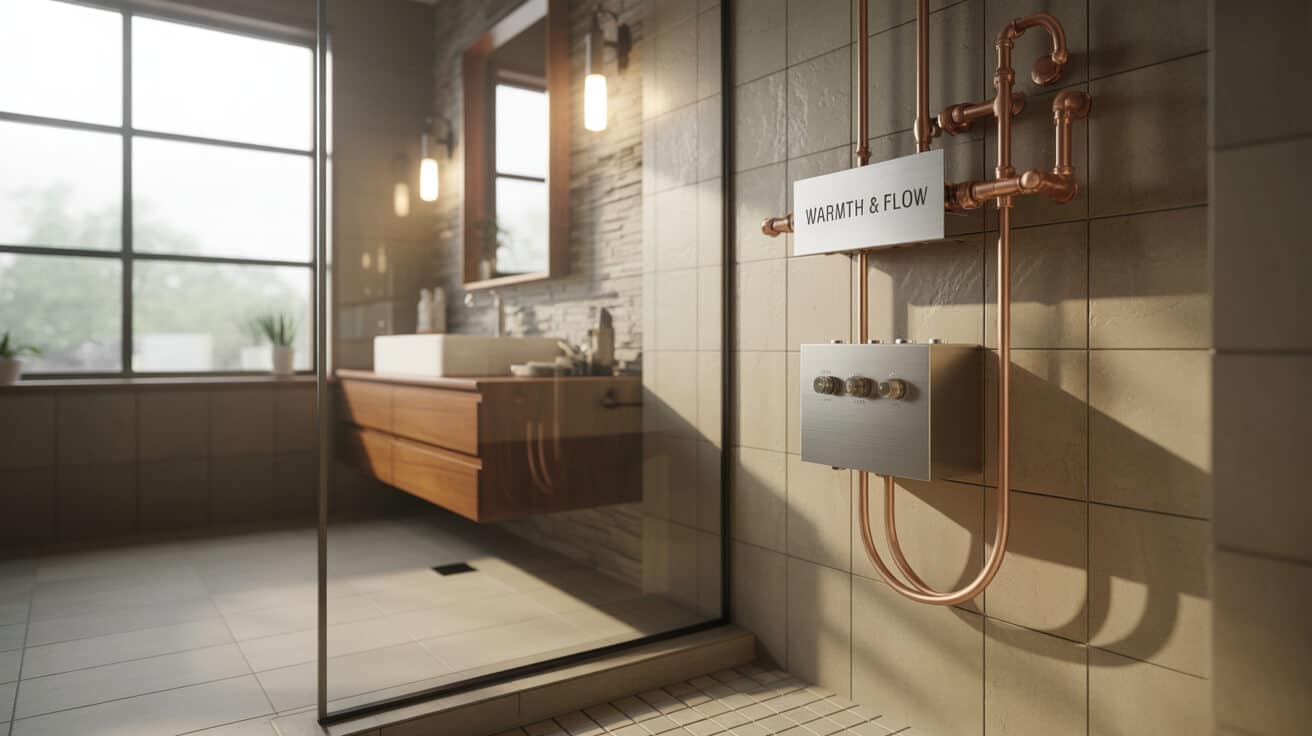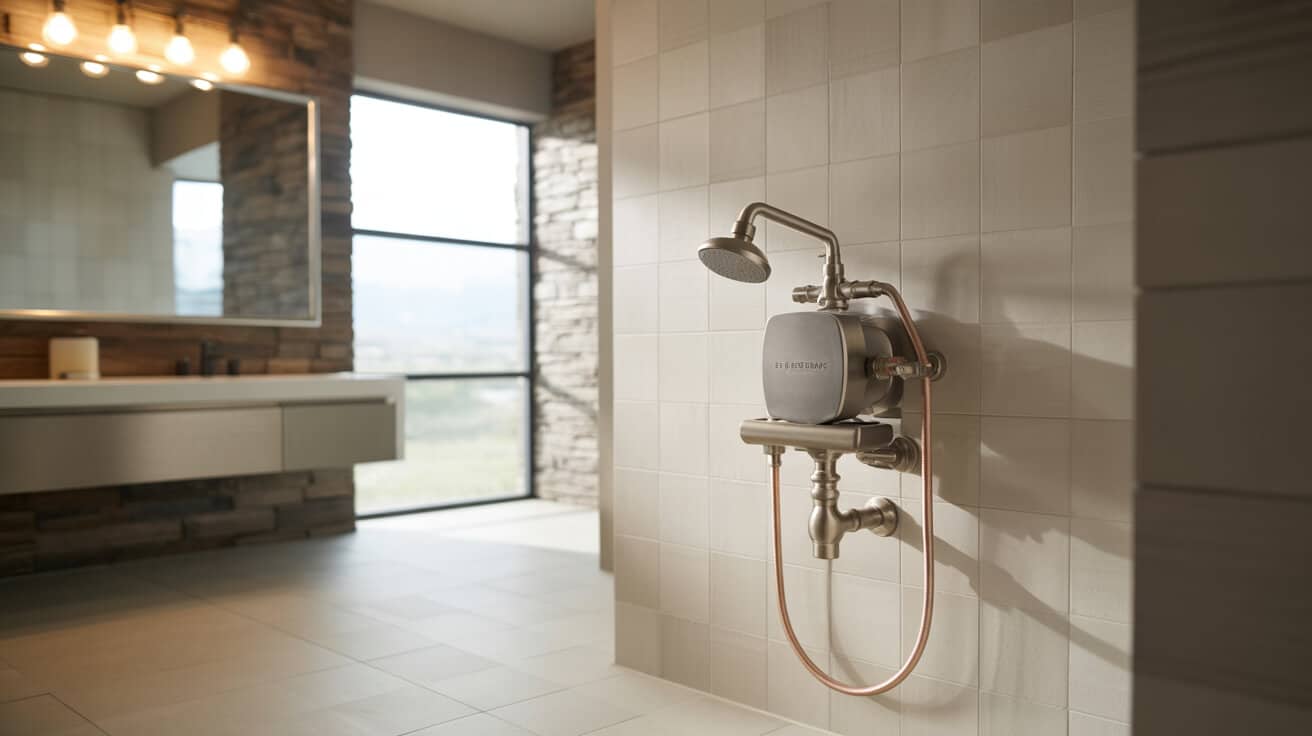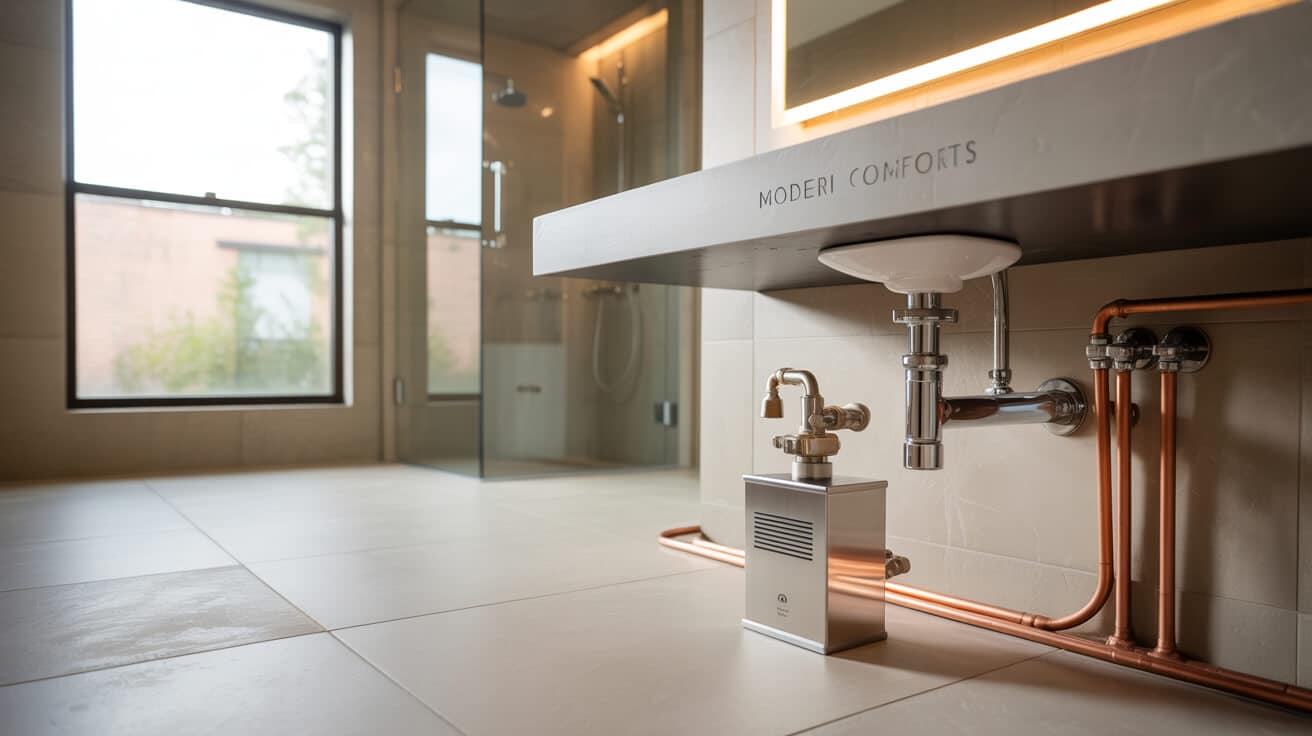Reliable water pressure is central to a satisfactory bathing routine, yet many buildings—especially older homes and multi-storey properties—experience chronically underpowered showers due to legacy gravity-fed systems or insufficient municipal supply. A shower pump intervenes in these scenarios by mechanically amplifying water flow, delivering a sustained, invigorating output even at remote or high-level outlets. Your goals as a homeowner, landlord, or facilities manager can be achieved through a shower pump installation that simultaneously solves day-to-day frustrations and aligns with British water regulations, supporting modern comfort standards and reducing the need for more invasive plumbing upgrades.
Plumbers 4U and similar plumbing and heating companies offer services that ensure compatibility assessment, regulatory compliance, and tailor installation solutions to your particular system, property archetype, and usage priorities. The decision to instal a shower pump thus crosses the technical, legal, and experiential dimensions of property management and improvement.
Etymology or name origin
The term “shower pump” denotes a specific class of electromechanical device explicitly designed to elevate water pressure at shower outlets. The phrase is now commonly distinguished from broader categories such as “water booster,” “macerator pump,” or “circulator,” all of which serve separate technical ends. In trade usage, “twin impeller pump” or “universal head pump” are frequent synonyms, referencing key mechanical features developed during regulatory differentiation in the late 20th century. These labels solidified in the British plumbing lexicon as water efficiency and building controls became more sophisticated, requiring greater specificity in nomenclature.
Overview / context
Shower pump installations answer the widespread challenge of insufficient water pressure, a persistent issue in UK properties reliant on gravity-fed cold-water tanks and conventional open-vented cylinders. Weak showers not only reduce user satisfaction but can indicate latent functional inefficiencies, negatively impacting property value and tenant or owner contentment.
The need for pressure boosting arises most commonly in:
- Traditional domestic properties, especially those with bathrooms at or above the level of storage tanks
- Houses converted into multiple flats with shared or extended pipe runs
- Refurbishments where upgrading the entire system to high-pressure (unvented/mains) would be impractical or cost-prohibitive
- Hospitality, leisure, and multi-unit settings where consistent service at multiple outlets is contractually required
Plumbing and heating specialists address these needs by specifying, installing, and maintaining shower pumps, harmonising comfort aspirations with necessary compliance and building standards.
Industry and building use
Shower pump installations have become a core service function within the British heating and plumbing sector, supported by a supply chain of specialist manufacturers, national standards bodies, and certified installers. Your organisation’s plumbing risks and opportunities are mediated by how your contractors or company adopt these technologies and compliance workflows.
History
Shower pump technology evolved in direct response to the practical deficiencies of gravity systems, a historical backbone of British domestic water supply since municipal tanked supply became standard in the 19th century. Initial enhancements featured basic piston pumps, later superseded by the advent of electric centrifugal systems in the post-war era.
Origins
Early devices, often manually actuated, were rudimentary and unreliable, largely serving single-point applications or agricultural supply needs. The technical leap to electric motors and compact impeller systems in the mid-20th century enabled routine domestic and light-commercial adoption, aligning with rising expectations of daily hygiene and convenience.
Industrial emergence
By the 1970s and 1980s, shower-specific pumps emerged as a category distinct from generic water boosters, spurred by specialist manufacturers and the increasing availability of thermostatic mixing valves. The regulatory environment responded with new standards (WRAS approvals, British Standards Kitemark) and the refinement of plumbing apprenticeship paths focusing on proper pressure management.
Contemporary evolution
In the modern era, shower pump design has prioritised noise reduction, energy efficiency, dry-run (no-water) protection, and advanced system diagnostics. Digital control overlays, acoustic insulation, and improved materials science have further professionalised installation, with companies such as Plumbers 4U emphasising fully compliant, future-proofed solutions as part of your asset management strategy.

Concept / description
A shower pump is fundamentally a compact, electrically powered device containing either one or two impellers (single/twin), integrated within a water supply line to increase the pressure and volume delivered to a dedicated fixture—primarily a shower. Activation is triggered by either flow (positive head) or pressure drop (negative/universal head), drawing water from storage tanks at atmospheric pressure and expelling it at force through reinforced flexible hoses.
Mechanisms and components
- Pump body and impeller: Central housing, usually brass or reinforced composite, containing a motor-driven spinning wheel (impeller) that transfers energy to the water, creating pressure and flow.
- Sensors and activation logic: Flow switches or pressure sensors determine operating state; negative head pumps activate even in the absence of gravity-induced flow.
- Flexible, reinforced hoses: Minimise vibration and accommodate minor pipe misalignment.
- Anti-vibration feet/mats: Isolate motor and hydraulic resonance from the building structure.
- Isolation and non-return valves: Ensure safe shut-off for service and prevent backflow into supply tanks.
- Dry-run protection and overheat sensors: Prevent pump operation when water is absent or when temperature exceeds safe operational bounds, defending against property damage.
- Electrical interface: Requires a dedicated 3A fused spur and often RCD (Residual Current Device) protection in line with electrical safety standards.
Brand and model differentiation
Leading manufacturers such as Stuart Turner, Salamander Pumps, Grundfos, and Monsoon dominate the market, each fielding product lines that address a spectrum of property types, power needs, and noise tolerances. Warranty duration, noise grade (dB), and compatibility with various shower types have become key artefacts of purchase and specification decisions.
Functionality / purpose / applications
Shower pumps are deployed to eradicate symptoms of low-pressure supply in showers, maximising comfort, health standards, and tenant or guest satisfaction. The technician’s role is not only to boost flow but to diagnose underlying causes and select a system congruent with both your plumbing architecture and lived expectations.
Practical use cases
- *Domestic property refurbishment*: Addressing family complaints about weak flow in upstairs bathrooms.
- *Commercial and institutional buildings*: Enabling simultaneous use across multiple showers in hotels, leisure centres, and care homes.
- *Adaptive retrofits*: Where full system upgrade to mains/unvented supply is uneconomical, a pump provides targeted relief without disruptive construction.
Deployment caveats
Certain systems—those with direct mains feed, sealed unvented hot water cylinders, or combination boilers—cannot accept standard shower pumps and require alternative methods. Safety, compatibility, and compliance are assessed and communicated transparently by service providers such as Plumbers 4U.
Classifications / types / variants
Modern shower pumps can be precisely classified based on activation principle, impeller number, power output, and operational design features. The following table summarises major distinctions:
| Type | Activation | Use Case | Common Placement | Notable Features |
|---|---|---|---|---|
| Positive head | Flow-activated | Gravity-fed, storage tank above | Adjacent to cylinder | Simpler installation |
| Negative/universal | Pressure-activated | Limited or no gravity flow | Remote, above/below | Can serve higher outlets |
| Single impeller | Hot/cold line | Only boosting one supply | In-line, at supply | Budget/space saving |
| Twin impeller | Both hot and cold | For mixers and thermostatic showers | Central, after tank | Balanced temperature |
Further subclassification includes output pressure (measured in bar), flow rate (litres per minute), and decibel-rated noise categories for sensitive installations.
Systems / tools / methodologies
A high-quality shower pump installation is a multi-phase process incorporating rigorous evaluation, precise preparation, technical adaptation, and detailed commissioning. Attention to each step ensures regulatory compliance, long-term reliability, and owner satisfaction.
Assessment and planning
- Inspect water supply architecture: identify gravity-fed vs. unvented/mains, tank sizes, pipe material/condition, electrical infrastructure.
- Calculate required flow and pressure based on expected shower performance and building layout.
- Select model considering noise sensitivity, operating hours, power consumption, and warranty.
Isolation and access
- Shut down water at main isolation valve and electrical supply at consumer unit.
- Drain local pipework using lowest outlet; open taps to vent excess and eliminate risk of spillage.
- Identify suitable mounting location allowing for service access, minimal noise transfer, and straightforward pipe runs.
Installation and connection
- Cut into supply lines using pipe cutters; fit isolation valves on both sides of pump for maintenance.
- For hot supply, instal either a Surrey flange (cylinder tapping) or Essex flange (side tank drilling) per brand recommendation.
- Affix anti-vibration feet and mat to pump; connect flexible hoses using manufacturer-provided joints/philtres.
- Wire pump to dedicated fused spur with RCD; route cabling for maximum safety and moisture avoidance; check compliance with BS 7671 wiring regulations.
- Refill system, vent airlocks, visually inspect all joints, and perform leak checks under static and dynamic flow.
Commissioning and verification
- Test pump activation (gravity/flow or pressure drop), ensuring consistent operation at full expected draw.
- Measure output at shower head—documenting flow rate, pressure, and acoustic output with calibrated instruments.
- Demonstrate system to you or your property manager, covering:
- Emergency isolation procedure
- Scheduled maintenance (philtre cleaning)
- Manufacturer warranty registration
Maintenance and documentation
- Record installation data, including model, pressure/flow, electrical safety results, installer credentials (WaterSafe/WRAS), and digital photos for compliance verification.
- Establish maintenance schedule (often annual), noting that failure to maintain may void warranty or insurance cover.
Tools required
- Pipe cutter (copper/plastic)
- Adjustable wrench
- Anti-vibration mat/feet
- Flexible hose adapters
- Electrical tester (RCD)
- Drill with core bits (for flanges)
- Leak detection spray
- Flow rate/pressure gauge
- Manufacturer installation guide

Stakeholders / entities involved
The successful realisation of a shower pump installation is a multi-stakeholder undertaking, relying on the complementary expertise, authority, and interests of various parties. Each step brings specific responsibilities and expectations.
Service providers
- Plumbers 4U and similar firms: Offer full-service solutions from compatibility audit through to post-instal maintenance, ensuring your peace of mind and regulatory alignment.
- Plumbing and heating engineers: Certified by NVQ, WRAS, or WaterSafe; responsible for technical execution and quality assurance.
- Electricians: Provide legal and safe fixed-wiring to pumps, essential for insurance and regulatory compliance.
Property-side participants
- Homeowners: Seek property improvements and higher comfort/luxury standards, accountable for upkeep and warranty terms.
- Landlords and property managers: Require reliable installations for letting, rental compliance, and asset protection.
- Facilities managers: Safeguard operational uptime and satisfaction across multi-resident or service-based settings.
Institutional and legal
- Manufacturers and suppliers: Certify product, provide warranties, and deliver technical support.
- Regulators and local authorities: Enforce safe plumbing practices and water security.
- Insurers: Require evidence of compliant installation for ongoing property risk cover.
Legal / regulatory / ethical considerations
Shower pump installations fall under an intertwined web of British water safety, product quality, and electrical protection standards. Failure to comply exposes your organisation or property to insurance nullification and legal risk.
Water, building, and electrical standards
- WRAS approval: Ensures the selected product is fit for connection to UK water supplies; failure to use approved makes can risk contamination and legal liability.
- Building Regulations (Part G): Dictate hot/cold water storage and delivery systems for new and modified installations; ensure health and hygiene compliance.
- Water Supply (Water Fittings) Regulations 1999: Proscribe improper system adaptation; require anti-backflow devices and easy-to-service fixtures.
- Part P (Electrical Safety): Demands that only qualified, registered electricians perform fixed wiring; compulsory RCD protection for bathrooms.
- British Standards (BSI Kitemark): Certify product durability, performance, and safety; insurance companies may require evidence of installation by recognised trades.
Installer and property-owner obligations
Your installer must maintain up-to-date accreditations; WaterSafe or manufacturer-approved status is often needed for warranty and council acceptance. You or your business is generally responsible for:
- Ensuring notification to authorities where necessary
- Securing access for periodic inspection by water company officials or landlords
- Keeping documentation for insurance, warranty, and property records
Ethical practice
Professional plumbers ethically advise only on compatible systems, clarify the limits of performance improvement, and offer a transparent schedule of both installation cost and aftercare. Companies such as Plumbers 4U embed compliance, reliability, and safety into every project, supporting your long-term interests.
Performance metrics / data / measurements
The operational excellence and value of a shower pump installation is determined by quantifiable metrics, used by both engineers and your business or household to track system health, efficiency, and user perception.
Typical measurement data
| Metric | Example Value/Range | Purpose |
|---|---|---|
| Output pressure | 1.5–3.0 bar | Satisfies most shower types |
| Flow rate | 10–30 litres/min | Real shower experience |
| Operating noise | 45–65 dB | User comfort |
| Power consumption | 200–450 watts | Electrical efficiency |
| Maintenance interval | Annual (typical) | Lifecycle planning |
| Mean time before failure | 4–7 years (with servicing) | Warranty alignment |
Diagnostics and testing
Upon installation, and at each maintenance event, practitioners measure static and dynamic pressure, record noise levels using acoustic metres at defined distances, and check for vibration. In multi-pump installations, synchronisation and anti-cycling protocols are verified to minimise wear and maintain consistency.
Maintenance and monitoring
Early detection of issues relies on flow, noise, heat, and electrical system logs. You and your property agent are offered scheduled maintenance packages by Plumbers 4U, minimising the risk of unplanned repairs and maximising warranty life.
Challenges / barriers / limitations
Detailed planning and regular maintenance alleviate, but never wholly erase, the unique challenges of shower pump installation. Each property type, water system, and occupier goal introduces distinct variables.
Technical and operational limitations
- System incompatibility: unvented cylinders and combination boilers are not compatible with standard shower pumps. Attempting incorrect installation can cause property damage or breach local regulations.
- Space/access: Pump installation may be complicated by confined lofts or cylinder cupboards, irregular building fabric, and water tank modifications.
- Noise and vibration: While modern pumps have improved acoustic control, wooden floors and late-night operation can result in transmitted nuisance.
- Electrical access: Lack of a nearby fused spur or safe wiring increases project cost and requires professional rectification.
User-side risks
- Maintenance neglect: Lapsed annual servicing, especially philtre cleaning and leak checks, escalates the risk of failure and invalidates warranty.
- Limescale: Properties in hard water areas experience greater pump wear; supplementary water softeners may be recommended.
- Service disruption: Retrofits or major upgrades can temporarily sideline showers, requiring staged scheduling for tenant satisfaction.
Compliance and insurance
Substandard work or ignored documentation opens the door to insurance denial and property legal action. Your diligent record-keeping and selection of accredited trades is a basic safeguard.
Impact / influence / legacy
A well-executed shower pump installation not only establishes immediate function and comfort but also echoes across several strategic property domains:
- Asset enhancement: Improved showers boost tenant, guest, or owner satisfaction, reflected in online reviews, higher occupancy, and resale appeal.
- Compliance and security: Adherence to standards by certified installers underpins insurance reliability, regulatory peace of mind, and streamlined asset management for your business.
- Professional reputation: Plumbers 4U’s commitment to quality—evident in transparent quoting, qualified workforce, and comprehensive aftercare—reinforces your trust and the reputation of your home or organisation.
- Knowledge transfer: The normalisation of best-practice installations elevates the training environment for the next generation of engineers, raising quality standards industry-wide.
Future directions, cultural relevance, and design discourse
Shower pump technologies are converging toward quieter, ultra-reliable, and eco-sensitive design, influenced by evolving customer demands and sustainability frameworks. Integration with building energy controls and granular diagnostics could herald an era where invisible infrastructure meets visible results—presenting water efficiency not as a regulatory burden but as an aspirational property feature.
Changing social attitudes toward personal comfort, water responsibility, and in-home luxury amplify the narrative of the modern shower pump from back-of-cupboard utility to an essential enabler of everyday comfort in your home or organisation. As smart materials, regulatory standards, and installation cultures continue to evolve, the value of certified professionals and tailored advisory from companies such as Plumbers 4U remains a cultural constant—demonstrating that even the most “hidden” system plays a visible role in quality of life and asset value.

